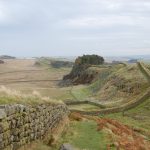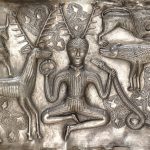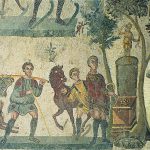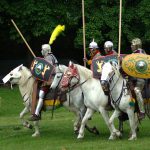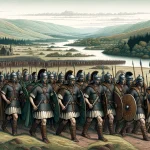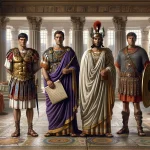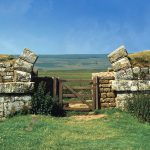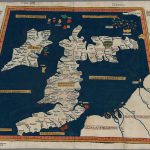Corbridge (Coriosopitum) Roman Fort and Town
Roman Bridges, Stanegate Fort, Supply Depot, Temple Or Shrine, Vexillation Fort and Vicus
Coriosopitum is strategically placed beside the lowest fordable point of the Tyne, close downstream of the confluence of its North and South streams. Dere Street crossed the river here on its journey north from Eburacum (York) and continued northwards across the river into Barbaricum.
There is evidence of Iron Age round houses on the site at Corbridge. The first Romans in the area built the Red House Fort, 0.5 mi (0.80 km) to the west, as a supply camp for Agricola’s campaigns. Soon after Roman victories in modern Scotland, around AD 84, a new fort was built on the site with turf ramparts and timber gates. A second timber fort was built, guarding an important crossing of the River Tyne, when the Solway Firth–Tyne divide was the Roman frontier. Around AD 120, when Hadrian’s Wall was built, the fort was rebuilt again, probably to house infantry away from the Wall. About twenty years later, when the frontier was pushed further north and the Antonine Wall built, the first stone fort was erected under the Governor Quintus Lollius Urbicus.
After the Romans fell back to Hadrian’s Wall in AD 163, the army seems to have been largely removed from Coria. Its ramparts were levelled and a big rebuilding programme of a very different nature was instigated. A series of probable temples were erected, followed by granaries, a fountain house and a large courtyard complex, which may have been intended to become a civilian forum or a military storehouse and workshop establishment. It was never finished in its original plan.
Burnt timber buildings may relate to Cassius Dio’s reference to tribes crossing the frontier but by the early 3rd century there was more construction. Two compounds opposite the supposed forum were built as part of a military supply depot within the town. It was connected with the Second and the Sixth Legion and may have been part of the supply network for Septimius Severus’ northern campaigns.
Information on the 3rd- and 4th-century town is lacking but an elaborate house was certainly put up which may have housed an Imperial official. Coria was probably a big market centre for the lead, iron and coal industries in the area, as well as agriculture, evidenced by the granaries. A pottery store has also been identified. When occupation came to an end is unclear. It is not even known if the site was still occupied when the Anglo-Saxons arrived to found adjoining Corbridge.
The Garrison Units of Roman Corbridge (Coriosopitum)
The Corbridge garrison was composed of legionary cohorts taken at various times from several of the Roman legions which were stationed in Britain. The first to arrive was Legio II Augusta from Caerleon in south Wales, who were stationed here under governor Quintus Lollius Urbicus around 140AD, followed in the late second century by cohorts of Legio VI Victrix from York. The cohorts from the Sixth Legion were augmented for a short time by contingents from Legio XX Valeria who were moved up from their legionary fortress at Chester in Cheshire during the administration of Sextus Calpurnius Agricola. The last legionary cohort recorded at Corbridge was from the Sixth, dated to the turn of the third century.
RIB 1125 - Dedication to the Concord of the Sixth and Twentieth Legions
“To Concordia,¹ the Sixth Legion, Victorious, Loyal and Faithful and the Twentieth Legion [dedicates this].”
AE LEG VI
VI P F ET
LEG XX [ ]
- Concordia was the Roman goddess of peace and friendship. Evidently, there was a certain amount of friction between the legionaries from the Sixth and the Twentieth.
Legio Secundae Augusta – The Second Augustan Legion
The name of the The Second Augustan Legion appears on three stones from Roman Corbridge.
RIB 1130 - Dedication to Jupiter Optimus Maximus
To Jupiter, Best and Greatest, for the welfare of the detachments of the Twentieth Legion Valeria Victrix and of the Sixth Legion Victrix the soldiers on garrison-duty ..
[...]RO SALVT[...]
[...]EXILLATIO
NVM LEG XX [ ]
[...]T VI VIC MI[...]
[...]GE[...]T IN P[...]
No commentary.
RIB 1154 - Inscription
A detachment-flag of the Second Legion Augusta.
LEG II AVG
vexillus is a solecism for vexillum, cf. CIL iii 79, 1193 (ILS 2746).For a description of the decoration see Richmond loc. cit.For a comparable text see RIB 1707.
Sextae Victrix – The Sixth Victorious Legion
There are at least a dozen stones bearing the name of the Sixth Legion ; including three dateable to the latter half of the second century, three altarstones and a tombstone.
RIB 1132 - Inscription
…a detachment of the Sixth Legion Victrix Pia Fidelis (set this up) under Gnaeus Julius Verus, emperor’s legate, through the agency of Lucius …, military tribune.
VE[...]
VI [...]
CN IVL [... ...]
PER L [ ...]
TRIB [...]
Cn. Julius Verus was governor about a.d. 155-about 159 (Birley in Askew Coinage 81).
RIB 1137 - Dedication to the Invincible Sun-god
To the Invincible Sun-god a detachment of the Sixth Legion Victrix Pia Fidelis set this up under the charge of Sextus Calpurnius Agricola, emperor’s propraetorian legate.
VEXILLATIO
LEG VI VIC P F F
SVB CVRA SEX
CALPVRNI AGRICO
LAE LEG AVG PR PR
Agricola, about A.D. 162-8. Line 1 was probably erased in A.D. 193, after the death of Commodus (Cumont, quoted by Haverfield NCH). The inscription can hardly have survived the barbarian destruction about 196, so as to suffer erasure on the death of Elagabalus in A.D. 222.
RIB 1190 - Fragmentary inscription
… the Sixth Legion Victrix ..
[...] TITICIA [...]
[...] VI BRIV[...]
[6] TAE [...]
[...] L VI VIC F
In view of its separation from the rest of the text the significance of the final f in l. 5 is not clear: a p for P(iae) F(idelis) may have dropped out. If, however, no letter is missing, f would stand for f(ecit). Supposing the subject of f(ecit) were the legion, the stone might be interpreted as a building-stone if it were not for the difficulty of recognizing any indication of building-activity in ll. 1-4. If, on the other hand, the subject was not the legion, membership of the legion could be indicated by l. 5, as for example in a dedication or, more probably, a tombstone. Nothing in ll. 1-4 seems to furnish a clue R.P.W.
RIB 1120 - Altar dedicated to Apollo Maponus
To Apollo Maponus, Quintus Terentius Firmus, son of Quintus, of the Oufentine voting-tribe, from Saena, prefect of the camp of the Sixth Legion Victrix Pia Fidelis, gave and dedicated this.
MAPONO
Q TERENTIVS
Q F OVF
FIRMVS SAEN
PRAEF CASTR
LEG VI V P F
D D
Saena: Sena Julia, in Etruria, belonged to the Oufentine tribe. Praefectus Castrorum: Prefect of the Camp, the most senior position for a centurion, after which came promotion to the order of knights, perhaps with a further career as a military tribune in command of an auxiliary infantry unit.
RIB 1122 - Altar dedicated to Maponus Apollo
To the god Maponus Apollo, Publius Aelius …, centurion of the Sixth Legion Victrix, willingly and deservedly fulfilled his vow.
[...]APO[...]
APO[...]
P AE[...]
LVS 𐆛 [...]
[...]IC V [...]
No commentary.
Legio Vicesimae Valeria Victrix – The Twentieth Legion, Valiant and Victorious
The name of the Legio Vicesimae Valeria Victrix – The Twentieth Legion, Valiant and Victorious appears on five stones from Roman Corbridge, and it seems that a Vexillatio of at least one cohort undertook building work during the latter part of the second century. This posting placed contingents from two separate legions in Corstopitum at the same time, and appears to have been cause of some disharmony, as the only altarstone dedicated by the Twentieth is one to Concordia, the dedication of which is significantly shared with the Sixth Legion (see RIB 1125 above).
RIB 1149 - Dedication to Antoninus Pius and Lucius Verus
For the Emperor-Caesars Marcus Aurelius Antoninus Augustus, in his 17th year of tribunician power, thrice consul, and Lucius Aurelius Verus Augustus, conqueror of Armenia, in his third year of tribunician power, twice consul, a detachment of the Twentieth Legion Valeria Victrix built this under the charge of Sextus Calpurnius Agricola, imperial propraetorian legate.
M AVRELIO A[... ...]
POTESTATI[ ... ] COS [... ...]
[... ...] A[...]
[...]S I[...] CO[...] II
[... ... ...] V V FECIT SV[ ]VRA
[...] AGRICO[...]AE
[...]M PR PR
No commentary.
RIB 1172 - Funerary inscription for Flavinus
To the spirits of the departed: Flavinus, trooper of the cavalry regiment Petriana, standard-bearer, from the troop of Candidus, aged 25, of 7 years’ service, lies buried here.
EQ ALAE PETR SIGNIFER
TVR CANDIDI AN XXV
STIP VII H S
This inscription seems to belong to the first century, as the squadron is not here given the honorary title C. R. which occurs on a diploma of A.D. 98, CIL xvi 43 (see Birley, Dumfriess. and Gall. NHAST 3rd Ser. 35 (1956-7), 11).
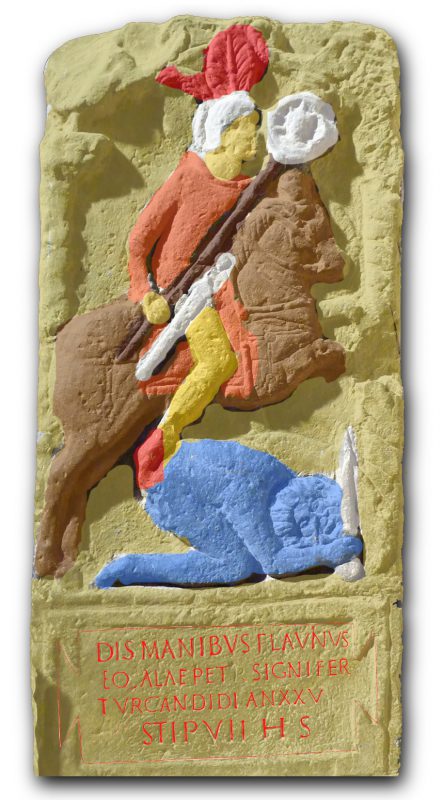
RIB 1178 - Fragmentary funerary inscription
… emeritus, formerly trooper in the … cavalry regiment ..
[...]AE
A emeritus was a time-expired soldier, equivalent to veteranus.
RIB 1128 - Dedication to the Discipline of the Emperors
To the Discipline of the Emperors the soldiers of the First Cohort of Vardullians, one thousand strong, Roman citizens, part-mounted, under the command of Publius Calpurnius Victor, (set this up).
[...]ES COH I V[...]
[...]RVM ↀ [ ]
[...] PRAEES[ ...]
[...]NIVS VIC[...]
‘The plurality of Emperors indicates that it cannot be earlier than Marcus and Verus (A.D. 161-9)… . If the whole unit was in garrison at Corbridge, there is some difficulty in finding a date at which it was free for service there, though a second-century stay would fit well if [Calpur]nius Vic[tor] is to be equated with …..]rnius [……] trib(unus), who dedicated a second-century altar to Apollo Maponus (RIB 1121). Since, however, the dedication is made by milites of the cohort, and not by the unit as such, it is possible that these soldiers may have been seconded for special duties.’ Richmond, Arch. Ael. 4th Ser. 21 (1943) 168. Addenda from RIB+add. (1995): This is the only dedication by the milites of an auxiliary cohort, a term otherwise used by legionary detachments in dedicating altars (e.g. RIB 1955 and 1956), so it would seem that the cohort was incomplete; cf. RIB 1421, an altar dedicated by a detachment of it nearby at milecastle 19.
Cohors Primae Lingonum Equitata
Cohors Primae Lingonum Equitata was a part-mounted unit originating from the Lingones tribe of Gallia Lugdunensis, inhabiting the Bourgogne region of Central France. The First Cohort of Lingones is known from inscriptions at Bremenium (High Rochester, Northumberland; RIB 1276; 139-43AD) and Longovicium (Lanchester, Durham; RIB 1091/1092; 238-44AD), and possibly also here at Corbridge, where it is recorded on a single undated stone (RIB 1186 below), which is missing the unit number.
RIB 1186 - Fragmentary building inscription
… the First Cohort of Lingonians Iliomarus ..
LING
ILIOM
[...]
The inscription on the two outer faces may have been completed on adjacent stones. For the Celtic name Iliomarus see CIL xiii 2724, Holder s.v., and for the cognate form Illiomarus CIL xii 2895, xiii 3063 (ILS 4695) Holder s.v., Oswald Stamps s.v.
The Roman Military Encampments
The Agricolan Vexillation Fortress at Beaufront Red House
This large early installation is described on a separate page: Beaufront Red House.
The Stanegate Auxiliary Forts at Corbridge
A Trajanic coin sealed beneath the rampart of the Stanegate fort at Corbridge proves a foundation date of 103AD or later, at the same time that the emperor Trajan was withdrawing troops from Britain (and elsewhere) for deployment in his second Dacian campaign which commenced in 105. It would appear that the original (Agricolan?) fort was burnt to the ground and the area levelled shortly after 103AD. This is not indicative of barbarian activity, who would hardly be mindful to carefully level the ground after a night’s arson attack, but is sure evidence of careful preparation of the foundations for another, larger fort built upon the same site during the early-Trajanic period. This complete rebuilding of the former fort is evidence of a change in the type of garrison unit housed at the site.
- Phase I (circa AD 86-103) The earliest fort on the site was also the largest, with defenses of turf and timber; it is possible that this fort and the nearby fortress at Beaufront Red House were occupied at the same time. The fort was deliberately dismantled and its timbers burnt.
- Phase II (circa AD 105-122) The turf-and-timber defences of this fort were built directly upon the destruction layer of Fort I; the principia and the praetorium of this fort were the first buildings of stone.
- Phase III (circa AD 122-139) There is evidence to suggest that the Corbridge site underwent a change of garrison during the Hadrianic Period, to maintain watch over the Tyne Bridge during the construction of the Hadrianic barrier.
- Phase IV (circa AD 139-163) This building phase is attested by a couple of inscriptions recording the work of the Second Legion during the governorship of Quintus Lollius Urbicus.
There is evidence of another rebuild and accompanying change of garrison in the early Hadrianic period, and a certain amount of rebuilding during late-Antonine times in the mid-second century is attested by an inscription of governor Sextus Calpurnius Agricola, who replaced Priscus around 162AD. This probably indicates the strengthening of the Hadrianic and Stanegate barriers following the withdrawal from the The Antonine Wall in Scotland. By the 3rd century Corbridge had grown into a large sprawling garrison town of 12 hectares enclosed by walls and housing a legionary garrison at its centre.
The dimensions of the auxiliary forts at Corbridge are unknown, but judging from the size of the garrison units, two of which contained a nominal one-thousand men and/or horses, the forts must have covered an area of at least 8 or 9 acres (c.3.6ha). It is noteable that of all the forts on the Northern frontier only Corbridge has yielded Saxon artefacts, perhaps indicating that the Hadrianic barrier a couple of miles to the north continued to keep barbary at bay, at least for a while.
RIB 1151 - Dedication to Septimius Severus, Caracalla, and Geta
The Emperor Caesar Lucius Septimius Severus Pius Pertinax Augustus and the Emperor Caesar Marcus Aurelius Antoninus Pius Augustus and Publius Septimius Geta Caesar built this granary through the agency of a detachment of the … Legion … under Lucius Alfenus Senecio, imperial propraetorian legate.
PERTINAX ET IMP C[...]ESAR M
AVR ANTONINV[...] PIVS AVG
VSTI ⟦ET P SEPTI[...]VS GETA
CAESAR⟧ HORRE[...]M [...]
VEXILLATIONE[ ...]
FECERVNT SV[ ...]
[...] AVG [...]
A.D. 198-209, probably about 207-8. Senecio was legate from 205 to about 208.
The latest datable inscription found at Corbridge is RIB 1151, a restored inscription for which there are two feasible concluding lines (see above). Lucius Alfenus Senecio governed Britain from c.205AD to 208 and is the last known governor of the entire British province before it was partitioned by the emperor Septimius Severus sometime before his death at York in 211. Gaius Valerius Pudens was the immediate predecessor of Senecio, and governed Britain from c.202AD to 205.
During excavations over the years at Corbridge a number of animal bones have been uncovered, including those of domesticated Ox, Sheep, Goats and Pigs, game such as Red Deer, Roe Deer, Wild Ox and Hare, also animals such as Fox, Badger, Beaver, Vole and Mole; the latter group very likely being hunted and killed for sport and as a means of pest control. Among the bones recovered from the Red House site were those of Ox, Sheep, Goat, Pig, Red Deer and Roe Deer.
Epigraphic evidence found at Roman Corbridge (Coriosopitum)
The Second Legion is mentioned on at least eleven inscribed stones recovered from the Corbridge environs. Aside from the usual clutch of ‘cohort stones’ (vide supra) which proclaim responsibility for the structure of the defences and internal buildings, there are a couple of inscriptions which provide invaluable dating information (RIB 1147 & 1148), culturally important altarstones dedicated to classical gods (RIB 1127 & 1136), also a single tombstone to an unnamed soldier (RIB 1177); all texts shown below.
Dating Information
RIB 1147 - Inscription
For the Emperor Titus Aelius Antoninus Augustus Pius, consul for the second time, under the charge of Quintus Lollius Urbicus, emperor’s propraetorian legate, the Second Legion Augusta built this.
[...]G PIO II COS
[...] CVRA Q LOLII VRBICI
[... ]VG PR PR LEG II AVG F
Antoninus Pius was emperor from 10th July 138AD until his death from natural causes on 17th March 161. He was consul I 120AD, cos II in 139, III in 140 and consul IV in 145. The title Pater Patriae was bestowed in late 139. Quintus Lollius Urbicus
RIB 1148 - Imperial dedication to Antoninus Pius
For the Emperor Caesar Titus Aelius Antoninus Augustus Pius, in his third consulship, father of his country, under the charge of Quintus Lollius Urbicus, emperor’s propraetorian legate, the Second Legion Augusta built this.
ANTONINO A[...] PI[...]
III CO[...]
SVB CVRA Q [...]
LEG AV[ ...]
LEG II A[...]
See 1148
Altarstones dedicated to classical gods
RIB 1127 - Dedication to the Discipline of the Emperors
To the Discipline of the Emperors the Second Legion Augusta (set this up).
NAE
AVGVSTORVM
LEG
II
AVG
Haverfield pointed out that it could not be earlier than A.D. 161-9 (the first pair of joint Augusti), but may probably be Severan. ‘Its association with the sacellum founded in the third century suggests that the Augusti mentioned are likely to have been the Severi’ (Richmond).
RIB 1136 - Altar dedicated to Silvanus
To the holy god Silvanus the soldiers of the detachment of the Second Legion Augusta and the Guild of the Worshippers of Silvanus set up this altar from their own resources willingly and readily.
[...]S VEXIL
[...] II AVG ET C[...]
[...]G[...] SI[...]VANIANO
RVM ARAM DE SVO POS
VOL LIB
4. This cuneus seems to be unattested elsewhere R.P.W. Addenda from RIB+add. (1995): The reference is not to a military cuneus but to ‘the guild of the Worshippers of Silvanus’, cf. RIB 2422.52, col(legium) dei Sil(vani). Silvaniani are not expressly attested, but they are analogous with Herculani, Ioviani, Martiales, Mercuriales, etc.
The Civilian Settlement
At Corbridge, records have been obtained of roads and buildings over a wide area around the visible remains exposed by excavation. The main street fronting the two military compounds continues in an irregular course east and west. It is flanked by buildings, and other streets branch off to north and south. A third of a mile to the west is a Romano-British temple of normal plan. The outline of the precinct-wall, which encloses an area of perhaps 120 by 110 ft., and of a central building are clearly visible, though no trace remains on the surface.” (St. Joseph, 1951)
RIB 1171 - Fragmentary funerary inscription
To the spirits of the departed: []rathes, of Palmyra, a flag-bearer, lived 68 years.
[..]RATHES PAL
MORENVS VEXILA
VIXIT ANOS LXVIII
Vexillarius with the meaning ‘flag-maker’ (see Birley loc. cit.) is unsupported. The meaning ‘flag-bearer’ is very common, and extends to most kinds of unit, including numeri. Palmorenus, to judge from the use of such gentile names (e.g. Germanus, RIB 1449, 1483, and the very common plural use, e.g. RIB 2063) could describe a soldier of a numerus Palmyrenorum.Barates Palmyrenus set up a tombstone (RIB 1065) to his wife at South Shields. An identification with ..]rathes Palmorenus is tempting and was made by Haverfield. Barathes is common in Palmyra (see Inscriptions de Palmyre, fasc. iv 14, 15a, 15c; fasc. vii 15; fasc. viii ; fasc. x 105, 119) and also occurs in other parts of Syria (e.g. Corp. Inscr. Semit. ii, iii 4449, Damascus; IGLS v (1959) 2089, in Emesene). Thus, even if the names were the same, identity would remain uncertain R.P.W. Addenda from RIB+add. (1995): Birley Roman army (1953), 81-2, rightly objected that [Ba]rathes at age 68 could not be a serving soldier, but is not described as ex vexillario either. However, that he made or sold flags (vexilla) is not convincing. That he was the vexillarius of a corporation has been suggested by 83 (1954), 505, who notes that there were vexillarii in collegia fabrorum.
As always, the best epigraphic evidences of civilian settlement at Corbridge come in the form of tombstones.
Some Civilian Tombstones from Corbridge
RIB 1177 - Fragmentary funerary inscription
To the spirits of the departed soldier of the Second Legion [Augusta ..
MILES
LEG II [...]
[...]
The name of the deceased normally precedes the statement of rank; probably it was omitted here.
RIB 1180 - Funerary inscription for Ahteha (205-208AD)
To the spirits of the departed (and) to Ahteha, daughter of Nobilis she lived five years.
AHTEHE
FIL NOBILIS
VIXIT ANIS V
Dr. S. Gutenbrunner reported: ‘Ahteha is probably a pet name derived from a Germanic compound like Ä€htard or Ä€ctohildis.’
RIB 1181 - Funerary inscription for Ertola (212-217AD)
To the spirits of the departed: Sudrenus (set this up) to Ertola, properly called Vellibia, (who) lived most happily four years and sixty days.
SVDRENVS
ERTOLE NOMINE
VELLIBIA FELICISSI
ME VIXIT ANIS IIII
DIEBVS LX
The primary text on the panel was erased before this secondary text was cut.
RIB 1182 - Funerary inscription for Julia Materna (A.D. 43-410)
Julia Materna, aged 6 Julius Marcellinus (set this up) to his very dear daughter.
NA AN VI IVL
MARCELLINVS
FILIAE CARISSIMAE
No commentary.
The Gods of Roman Corbridge
RIB 1142 - Altar dedicated by Quintus Calpurnius Concessinius
… Quintus Calpurnius Concessinius, prefect of cavalry, after slaughtering a band of Corionototae, fulfilled his vow to the god of most efficacious power.
Q CALPVRNIVS
CONCESSINI
VS PRAEF EQ
CAESA CORI
ONOTOTAR
VM MANV PR
AESENTISSIMI
NVMINIS DEI V S
For the deity see crit. note to l. 1; it may well have been i · o · m do|licheno R.P.W. 5–6. Corionototae: an unknown tribe (Haverfield NCH), or sept R.P.W.
Over twenty altarstones have been uncovered at Corbridge, mostly dedicated to various gods from the classical pantheons of Greece and Rome, although the greatest number of altars to a single god is the Romano-British amalgam Apollo Maponus, to whom there are four dedications, closely followed by the Germanic god Veterus with three. The only other gods possessing more than one dedication are Jupiter and Discipline, each with two altarstones. There are single altars dedicated to Astarte (in Greek), Concordia, Diana, Hercules (in Greek), Mercury (in relief), Minerva, Panthea, Silvanus, Sol Invictus (Mithras) and Victory; there are another six altarstones dedicated to gods whose names are illegible or otherwise unknown. A selection of the more interesting examples are shown here.
RIB 1124 - Altar dedicated to Astarte (A.D. 43-410)
You see me, an altar of Astarte Pulcher set me up.
- Astarte was a powerful Syrian goddess, associated by the Greeks with Aphrodite and by the Romans with Venus.
- Pulcher was of peregrine status, for he lacked the tria nomina of a citizen.
- Presumably this altar came from the same shrine as RIB 1129, which also forms a hexameter verse in Greek.
RIB 1129 - Altar dedicated to Heracles of Tyre
To Heracles of Tyre Diodora the priestess (set this up).
- Tyre (or Tyrus) was an ancient city of the Phoenicians, built on an island a couple of miles from the coast of Syria; their principal deity was Hercules (or Herakles) for whom a magnificent temple was built, decorated with pillars of gold and emeralds. He was possibly worshipped here under the name Melkaart.
There are three altarstones recovered from Corbridge which are dedicated to the god Veterus or Vitiris (vide supra), an ancient German ancestral deity worshipped in Britain under a variety of names including; Veter, Veteres, Viter and Votris. The god is also known from altars at Concangis (Chester-le-Street, Durham; RIB 1046), Vindomora (Ebchester, Durham; RIB 1103) and Cataractonium (Catterick, North Yorkshire; RIB 727), also at many forts along Hadrian’s Wall.
RIB 1121 - Altar dedicated to Apollo Maponus
To Apollo Maponus, Calpurnius …, tribune, dedicated this.
MAPON[...]
[...]RNIVS
[4] TRIB
DEDICAVIT
No commentary.
RIB 1123 - Dedication to Arecurius
To Arecurius, Apollinaris, son of Cassius, willingly and deservedly fulfilled his vow.
ARECVRIO
APOLLINARIS
CASSI V S L M
2. arecvrio is plainly the reading. This is explained in two ways: (a) Arecurio, (b) since the image above the inscription is clearly that of Mercury, the name is probably, after all, a slip for Mercurio. Professor Birley, loc. cit., quoting Dr. S. Gutenbrunner, regards Arecurius as a Celtic deity, for whose name this is the sole instance; it would mean ‘of the district of Curia’. An alternative suggestion has been made by Professor E.G. Turner (letter of 6 Apr. 1955) that the deity was Mercurius and that the exemplar for the mason was written in cursive script. He considers that the mason misread the initial m as cursive ar, and by virtual haplography omitted the first r in Mercurius, owing to the close resemblance of cursive r and c. Addenda from RIB+add. (1995): The figure is now published as CSIR i, 1. 61, which notes that although adapted from a common type of Mercury, it carries none of his characteristic attributes. So it should be regarded as representing an otherwise unknown god, Arecurius.
Apollo, also known by the Romans as Phoebus (the sun), was the son of Jupiter and Latona, and brother of Diana (a.k.a. Phoebe, the moon). He was the god of the fine arts, music, poetry, medicine and eloquence, and reputed to be master of the bow and arrow, as was his sibling goddess. His temples are known throughout the Roman world, including many examples in Britain.
RIB 1126 - Altar dedicated to Diana
N… set up this altar to Diana.
DIAN
POSVI
N[...]
No commentary.
RIB 1133 - Dedication to Mercury
No translation
MERC
Mercury was the messenger of the gods and the patron of merchants.
Milestones from Corbridge, Northumberland
The Corbridge Classical Roman Temples
The sanctuary area of Corstopitum lay in two sections to the north of the military enclosures at the heart of the Roman town. The defenses of both the eastern and western compounds have a very un-military outline due to their methodical respect of the temples sacred boundaries. All of the temples so far discovered appear to be constructed in the classical style, which is to be expected in a town with a predominantly legionary population, all of whom were Roman citizens and thus inclined towards the classical pantheon. The eastern enclave contains at least five known temples (numbers 1 through 5) while the western enclave holds two (6 & 7). Unfortunately, although there have been several altarstones and religious artifacts turned-up in Corbridge over the years, none may be positively assigned to any of the classical shrines.
Corbridge Temple 1
The podium of this temple was composed of packed earth held within retaining walls of dressed stone measuring 24½ ft. wide by 33 ft. long. There were five irregularly-spaced columns along the northern front, the bases of which were 1 ft 4 ins. square, which would imply a column-height of between 10-12 ft. The north-east corner of the temple was destroyed, possibly during barbarian incursions south of Hadrian’s Wall around 296AD.
Corbridge Temple 2
Built alongside Temple 1 only 2 ft. to the east, the podium of this temple measured 31 ft. 5 ins. wide and at least 55½ ft. long. There were four columns set along the front of the temple, two spaced 10 ft. apart to either side of the door leading to the cella, the sanctuary of the temple. The form of the temple sanctuary was an open courtyard with surrounding roofed colonnade containing a massive platform set at the rear, probably to house an altar which was also open to the sky.
Corbridge Temple 3
Lying to the immediate east of Temple 2, all that survives of this temple is the front of the podium measuring 27 ft. wide; the original length is unknown.
Corbridge Temple 4
This temple is situated to the north-east of Temple 3, behind Temple 5, and unlike the three preceeding temples faced either west or east. Only the podium has survived, measuring 27 ft. 3 ins. wide by 32 ft. 8 ins. long.
Corbridge Temple 5
Like temple 4, this temple is oriented east-west and is known only from its podium, which measured about 26½ ft. wide by at least 43 ft. in length. It was situated to the immediate north of Temple 3 and just west of Temple 4, obscuring them both.
Corbridge Temple 6
This temple lies in the western enclave and is known only from its podium, which measures 12 ft. 8 ins. in width by 24 ft. 10 ins. long. It is the smallest known temple at Corbridge and is oriented north-south, its facade probably opened onto the street to the north.
Corbridge Temple 7
This temple lies to the immediate south of Temple 6 and is known only from the south-east corner of its podium, which was probably aligned east-west.
Classical References to Roman Corbridge (Corstopitum)
Further south are the Otalini, among whom are the following towns: Coria 20*10 59°00, Alauna 23*00 58°40, Bremenium 21*00 58°45.
There is an interesting passage in the early second century geographical treatise by Claudius Ptolemaeus (see above), in which he assigns a town named Coria to the Otalini or Otadini tribe, along with other towns Alauna and Bremenium. These settlements have all been identified with Roman sites in Northumberland, at Corbridge, Learchild and High Rochester respectively. The tribal name has now been equated with the VotadiniVotadini[/link_post], whose territories lay mostly within the county of Northumberland in north-east England, also in the Borders region of south-east Scotland.
There is further mention of the Roman name for Corbridge in the Antonine Itinerary of the late-second century. The first route listed for Britain in this document is entitled “From the Wall at the limits [of the empire], to Praetorium“, which lists the road-stations along the route from Hadrian’s Wall to Bridlington on the north-east coast of England. The second entry in Iter I is named Corstopitum, and is listed 20 miles from Bremenium (High Rochester, Northumberland) and 9 miles from Vindomora (Ebchester, Durham).
There is further mention of Corbridge in the The Ravenna Cosmography of the fourth/fifth century, wherein entry #142 appears as Corie Lopocarium, the first part of which has been equated with the Coria of Ptolemy (vide supra), but the suffix Lopocarium remains a mystery, and indeed, may even be the name of another town, as yet unidentified. The Corie entry appears between those of Concangis (Chester-le-Street, Durham) and Segedunum (Wallsend, Tyne & Wear).
References for Corstopitvm/coriosopitvm
- Air Reconnaissance of North Britain by J.K. St. Joseph in J.R.S. xli (1951) p.55;
- The Roman Inscriptions of Britain by R.G. Collingwood and R.P. Wright (Oxford 1965);
- Temples in Roman Britain by M.J.T. Lewis (Cambridge 1966);
- The Roman Military Diet by R.W. Davies, in Britannia ii (1971) pp.122-142;
- Chronology of the Ancient World by E.J. Bickerman (Thames & Hudson, London, 1980);
- Hadrian’s Wall in the Days of the Romans by Ronald Embleton and Frank Graham (Newcastle, 1984) pp.204-212;
- Corbridge: excavations of the Roman fort and town, 1947-80 by M.C. Bishop & J.N. Dore (HBMCE, 1989);
- Hadrian’s Wall Map and Guide by the Ordnance Survey (Southampton, 1989);
- Chronicle of the Roman Emperors by Chris Scarre (Thames & Hudson, London, 1995);
- Dictionary of English Place-Names by A.D. Mills (Oxford, 1998);
Roman Roads near Corstopitvm/coriosopitvm
Stanegate: W (6.75) to Cilvrnvm (Chesters, Northumberland) Dere Street: N (2.5) to Onnvm (Halton Chesters, Northumberland) Stanegate: ESE (15) to Washing Wells (Whickham, Tyne & Wear) Dere Street: SE (9) to Vindomora (Ebchester, Durham) Dere Street: N (2.5) to Portgate Dere Street: NNW (15) to Risingham (Risingham, Northumberland) Probable Road: SW (22) to Whitley Castle (Whitley Castle, Northumberland)
Sites near Corbridge (Coriosopitum) Roman Fort and Town
- Red House Roman Bath House (1 km)
Bath House - Sandhoe Fort (Beaufront Red House) (1 km)
Vexillation Fort - Sandhoe Temporary Camp (1 km)
Marching or Temporary Camp - Farnley Temporary Camp 1 (2 km)
Marching or Temporary Camp - Farnley Temporary Camp 2 (2 km)
Marching or Temporary Camp - Farnley Temporary Camp 3 (2 km)
Marching or Temporary Camp - Onnum (Halton Chesters) Vicus (4 km)
Vicus - Hadrian's Wall - Milecastle 22 - Portgate (4 km)
Hadrian's Wall Milecastle - Portgate (4 km)
Hadrian's Wall Milecastle and Portgate - Hadrian's Wall - Fort - Halton Chesters (Hunnum / Onnum) (4 km)
Hadrian's Wall Fort
